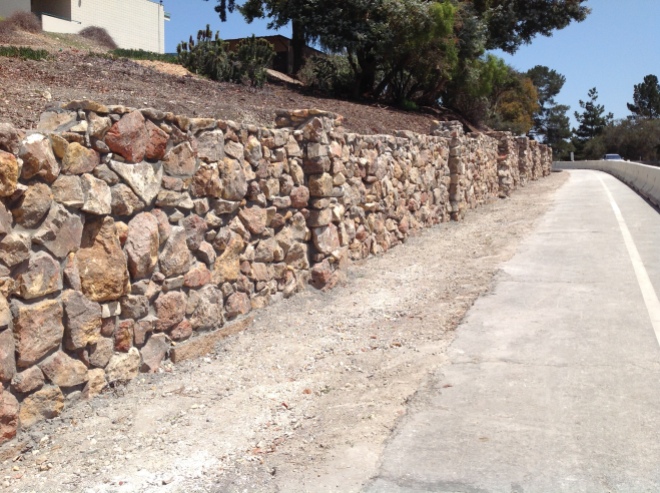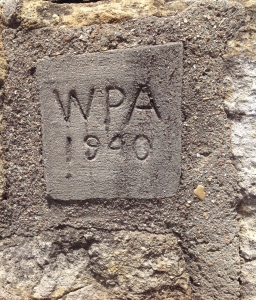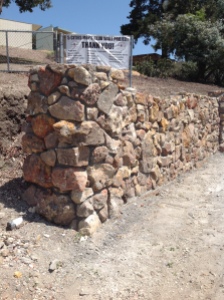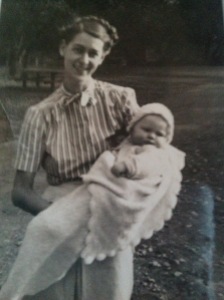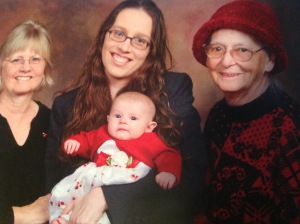Memories of My Father, Chester Arthur, by Gary Grieb
October 6, 1911 – June 15, 1982
Married Mildred Fox
Two Children: Gary Arthur Grieb – August 9, 1936 and Edith Ann Grieb – July 14, 1944 – February 12, 2013
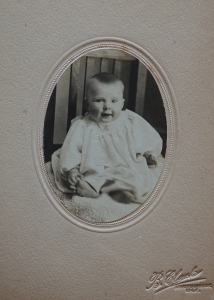
Chester Arthur at 6 Months

Childhood

Young Adult
An Outdoorsman
Dad seemed to really like the outdoors. If he wasn’t working hard he was going fishing or hunting. It seemed like we always had something wild to eat.
Sometimes at night Dad would take us over to Avila between the 2nd and 3rd pier.That small beach is where Dad and his cronies and of course all the families would go grunion hunting on the beach. When the grunion would come in on a wave and use their tail to dig a hole which they were ending up looking like they were standing in the hole on their tails. They would lay their eggs and then catch a wave back into the ocean. That’s when Dad would have a light on and we would see them and they try to catch them. We would get a bucket full,if we were lucky, go home and Dad would then clean them and we would have grunion for a few days to eat.
I remember one day after Dad had gone pigeon hunting he brought some pigeons and he said a cotton tail rabbit after he cleaned them. I had asked him because I was pretty young then what was that he had said a rabbit which was real good to eat. Of course I believed him but after we had eaten it he told me it was a tree squirrel. He must have felt guilty telling me it was a rabbit instead of a squirrel.
The International Truck
Dad and a bunch of his fishing buddies went trout fishing north of San Simeon. He took me with him in his International truck. It was really a fun trip.
I remember when Dad had bought the brand new International truck. It didn’t have a bed in the back, just a cab and frame. Every day after he had worked all day he would drive the truck up to Clyde Withrow’s welding shop and work on building a bed on the truck. When he and Clyde finished it looked like it came that way. To me this was how he survived being fruitful doing so many things himself.
A Family Man
Playing basketball my first year in high school. We went to Lompoc High School and Played. Dad came down in the car and watched the game. Afterwords, I got permission to ride home with Dad. I was really proud that he went all the way to Lompoc to watch me play and bring me home.
One day we were unloading our boxes of vegetable at Arroyo Grande trucking for them to haul our vegetables to LA to sell. He told me that he had driven truck hauling to LA. He was surprising me even once in awhile. He also said he was on a semi pro team here on the Central Coast and while doing this they had played the LA Rams which in those days was not a big professional team. He said in those days they were bad. They would play them in the evening under lights. He said the Rams would shove the football inside their jersey so Dad’s team couldn’t see where the football was. Would you believe he played the tackle position?
I was at the Taylor house playing with Denny in the evening. It got to be supper time and Denny and I because of playing never noticed the time. Dad came to pick me up in our Plymouth car which had running boards on it. I begged Dad to let me stand outside on the running board to ride home. I saw he really didn’t like the idea but I sweet talked him so he drove home real slow. We were just getting in front of our house. Dad hadn’t stopped yet and I decided to jump off while the car was moving and of course I fell down on the cement road and got the wind knocked out of me. Dad slammed on the brakes, jumped out of the car with a frightened look on his face picked me up and carried me into the house. He told me not to jump off a vehicle while it was moving and I could tell he wouldn’t ever let me ride like that again.
One day Dad was in the shed sorting and packing artichokes with Uncle Connie and I was out playing where I shouldn’t have and I opened the fill cap on the big gas tank and was smelling the gas fumes. For some reason Dad came checking on me because I seemed to like to get into mischief, and Dad found me up on the gas tanks laying there. I think I passed out and again I got carried into the house and Dad revived me.
Farm Life

Dad and Uncle Connie raised pigs at Uncle Connie’s farm in Los Berros. I will never forget killing a pig, carrying it down to one of the old oak trees in the back of the pickup after they had shot it in the head. They would winch the pig up in the air by it’s hind legs over a big metal drum. The drum must have been from the oil fields because it was thick steel open on the upper half with a fire underneath and boiling water inside. They would drop the pig into the water then raise it up, then start scraping the hair off. Dad would let me help him scrape. This would go on until they had gotten all the hair scraped off. Then they would clean the pig cutting it open taking all the insides out and washing it. Usually when I was there Dad did the cutting up, then they would haul it over to the walk in cooler at Grandpa’s ranch.
When I was in the first or second grade Mom and I went down to the apricot orchard where Dad was pruning. I had seen the advertisement somewhere, this was during World War II, selling these air force hats with goggles the pilots wore in those days. I asked Dad to buy one for me and he just grinned and kept pruning talking to Mom while working. I pushed pretty hard then I think a bud or something dropped in my eye.
It hurt and kind or burned and I told Dad if I had the hat with the goggles I wouldn’t have got something in my eye. About two days later after I had forgotten about the hat and goggles Dad gave me a little package and here was the air force hat and goggles which I really didn’t need. Times were hard and I now feel Dad really couldn’t afford to buy it.
Dad decided that the ground below the Hodges house where we lived in the adobe ground needed improving. He cut down a few walnut trees, borrowed Saratoris dirt scraper and started leveling. He leveled for about a week, not having any survey equipment disked and ripped the ground, furrowed it and planted vegetables. The leveling was almost perfect which dad did by sight with the water running perfect. To this day I couldn’t believe he could do everything himself without surveyors or big equipment to level with.
One time Dad came home with tomato plants. How many I don’t know but enough to cover about a half acre. He said let’s go plant these. So guess what I did that day? Dad put an empty barrel in the back of the pickup laying it down horizontally, put a valve “faucet” in the small plug which was on the bottom and filled the barrel with water through the big cap hole. We then went across the creek over to where he had disked up and had measured of where the plants were to be planted. We planted them and dad kept them watered. The plants did well and he would pick them and put them in the shed to finish ripening, then weekly would sort them picking out the ripe ones and shipping them for sale.
Dad was driving tractor disking on Saratori’s place across from the Halcyon store. I think mom dropped me off there so Dad let me got on his lap on the tractor. We were disking along with me watching Dad pull the levers to turn the cat and keep it going straight when he pulled one lever I pulled on the others and that disengaged the clutches and the tractor stopped for a second until I quickly let go. Boy Dad was sure startled. He gave me a “little” bawling out and we kept on disking of course getting dustier as well.
The Time I Went Missing

Art, Gary, Edith and Mildred
When I was pretty young, Dad was disking in the walnuts and artichokes behind our house on Uncle Henry’s farm on Valley Road. I got tired of riding with him so he stopped and got me off the tractor. We were about half way out in the orchard and artichokes. The ground is good and the artichoke plants grew big. I was sleepy after riding the tractor so made me a little bed inside a big artichoke plant. Dad hadn’t seen me do this, and I fell asleep inside the plant. It came time for dinner and Mom and Dad called me and of course I didn’t answer.
Dad and Mom were frantic looking for me. Dad went looking in the artichoke field, and I woke up and was getting out of inside the artichoke plant when here comes Dad looking a little shaken. He told me to be sure and tell one of them where I was going.
More Memories
One time I asked Dad why we didn’t have milk cows and he told me when he was going to school he had to be up early every day and milk and feed the cows morning and night. He had made up his mind when he went out on his own he would never be tied down milking cows.
I was talking to Andy David the attorney, dead now, one day and he told me how he would get Dad’s help in information from years back. Andy said that Dad had more true information than he had heard anywhere. Andy said when he had a case that needed information from the past he would sit down with Dad and get what he needed.
Thinking about Dad makes me think about how I believe he never stole anything or lied to anyone. I cannot think of one time that I had been with him that he wasn’t always friendly to everyone. He seemed to like to talk with people and most of the time be laughing and joking. I think he liked almost everyone and in front of me I never heard him talk bad about anyone which is better than myself.
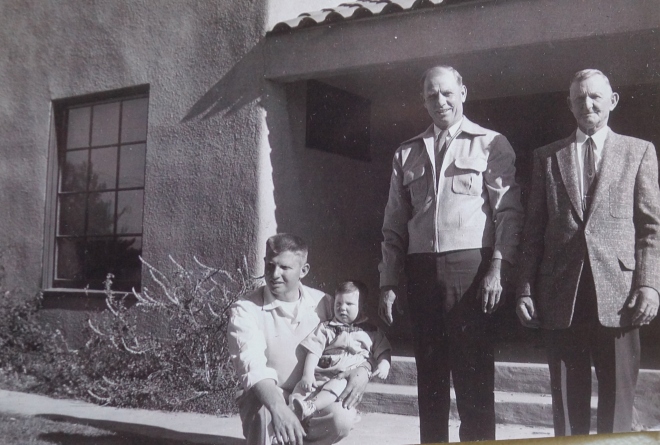
Four Grieb Generations: Gary holding Gary Jr., Art and Fred

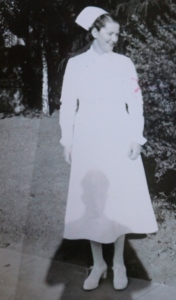
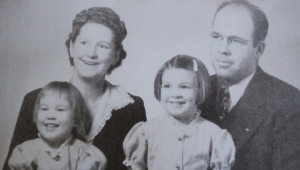
 She taught us how to cook, make pies, cookies, and make use of the abundance that came from the orchards, garden, lakes and ocean. That we had been taught how to prep fresh vegetables, prepare clams, abalone, trout and salmon, as well as cut up a chicken or rabbit or deer served us well over our adult years of outdoorsy life. And in those pre-permanent press fabric years, because of mom, we knew how to iron with a mangle, be pretty efficient with an iron, to be independent.
She taught us how to cook, make pies, cookies, and make use of the abundance that came from the orchards, garden, lakes and ocean. That we had been taught how to prep fresh vegetables, prepare clams, abalone, trout and salmon, as well as cut up a chicken or rabbit or deer served us well over our adult years of outdoorsy life. And in those pre-permanent press fabric years, because of mom, we knew how to iron with a mangle, be pretty efficient with an iron, to be independent.


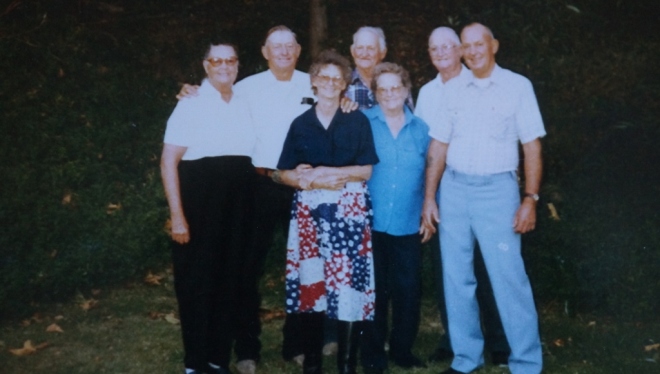

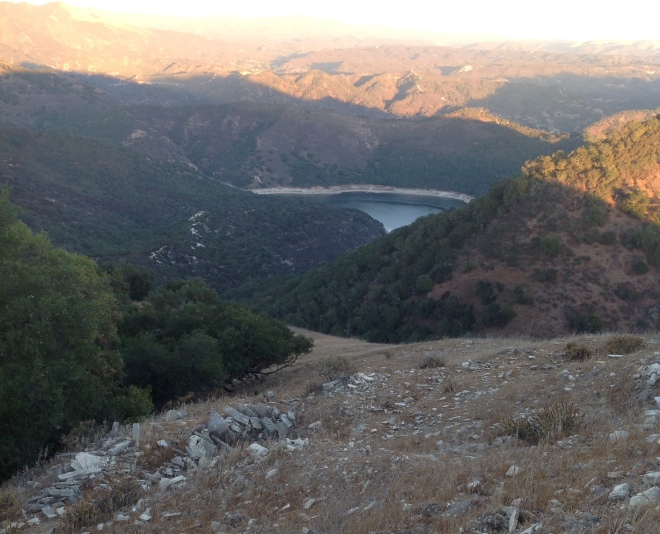
















 As an 8th grader, he joined the Arroyo Grande Men’s Horseshoe Team. They played other men’s teams from San Luis Obispo, Atascadero, Paso Robles, and Santa Maria. In high school he was the champion horseshoe player.
As an 8th grader, he joined the Arroyo Grande Men’s Horseshoe Team. They played other men’s teams from San Luis Obispo, Atascadero, Paso Robles, and Santa Maria. In high school he was the champion horseshoe player. Stan graduated from high school in 1941 and began 25 years of farming, raising apricots, walnuts, artichokes and vegetables.
Stan graduated from high school in 1941 and began 25 years of farming, raising apricots, walnuts, artichokes and vegetables.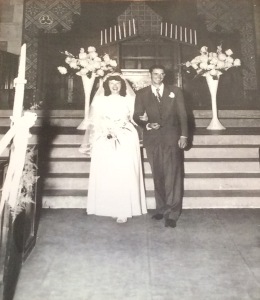 He met Lois Buchen on a blind date when her sorority, Alpha Delta Pi, at the University of California at Santa Barbara, had a dance.
He met Lois Buchen on a blind date when her sorority, Alpha Delta Pi, at the University of California at Santa Barbara, had a dance.
 In retirement Stan liked to spend his time in his yard, still the farmer, he “irrigated rather than watered”. He was always tinkering with something . With a mind to make things easier or better, he tinkered with and modified his bar-b-ques, trailer, and motorhome. He loved to camp at Lake Tahoe and spent several weeks every summer at the lake.
In retirement Stan liked to spend his time in his yard, still the farmer, he “irrigated rather than watered”. He was always tinkering with something . With a mind to make things easier or better, he tinkered with and modified his bar-b-ques, trailer, and motorhome. He loved to camp at Lake Tahoe and spent several weeks every summer at the lake.




